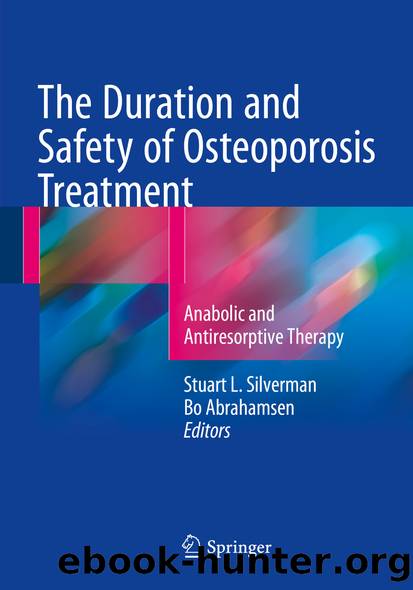The Duration and Safety of Osteoporosis Treatment by Stuart Silverman & Bo Abrahamsen

Author:Stuart Silverman & Bo Abrahamsen
Language: eng
Format: epub
Publisher: Springer International Publishing, Cham
Fig. 12.6Sixty-four-year-old male with a painless area of exposed bone and stage 1 ARONJ involving mandibular tori
Inflammatory signs and symptoms such as pain and erythema can be a common finding with ARONJ, usually with progression of disease past stage 1. Inflammation of soft tissues surrounding affected bone may result in the appearance of swollen and/or bleeding gingival tissues as shown in Fig. 12.7. Loosening of teeth may occur due to periodontal involvement of ARONJ. Purulence may be an important finding with disease progression and may be accompanied by malodor or bad breath. Culture of pus from ARONJ lesions with antibiotic sensitivity testing may help guide antimicrobial therapeutics, and notoriously pathogenic oral bacteria are usually cultured. Exposed sequestrum may be sharp, causing irritation and traumatic ulcers of adjacent mucosa such as the tongue or buccal mucosa. Figure 12.8 shows a ventrolateral tongue ulcer secondary to trauma from exposed sharp sequestrum in ARONJ. Patients with prosthodontic or dental appliances may complain of ill-fitting prostheses due to inflammatory changes in underlying affected tissues, and this can be an early symptom of ARONJ. With disease progression, patients may complain of difficulty eating or dysphagia, and weight loss can be observed in such cases. Fever is only seen in more severe cases or advanced-stag e disease. With fever or active purulence from lesions, systemic hematology lab values may show increased leukocyte counts, particularly lymphocytosis or neutrophilia with or without evidence of neutrophil bands.
Fig. 12.7Fifty-nine-yea r-old female with a stage 2 ARONJ lesion that bleeds spontaneously and has frequent episodes of exudate coming from the lesion, with concomitant malodor. The gingival swelling and bleeding can make it difficult to visualize the exposed subjacent bone; therefore, gentle saline irrigation may be required in order to do so clinically
Download
This site does not store any files on its server. We only index and link to content provided by other sites. Please contact the content providers to delete copyright contents if any and email us, we'll remove relevant links or contents immediately.
Men In Love by Nancy Friday(4972)
Everything Happens for a Reason by Kate Bowler(4481)
The Immortal Life of Henrietta Lacks by Rebecca Skloot(4264)
Why We Sleep by Matthew Walker(4193)
The Sports Rules Book by Human Kinetics(4081)
Not a Diet Book by James Smith(3156)
The Emperor of All Maladies: A Biography of Cancer by Siddhartha Mukherjee(2934)
Sapiens and Homo Deus by Yuval Noah Harari(2855)
Day by Elie Wiesel(2599)
Angels in America by Tony Kushner(2395)
Endless Forms Most Beautiful by Sean B. Carroll(2353)
A Burst of Light by Audre Lorde(2350)
Hashimoto's Protocol by Izabella Wentz PharmD(2206)
Dirty Genes by Ben Lynch(2164)
Reservoir 13 by Jon McGregor(2149)
And the Band Played On by Randy Shilts(2020)
Wonder by R J Palacio(1993)
The Immune System Recovery Plan by Susan Blum(1971)
Stretching to Stay Young by Jessica Matthews(1948)
